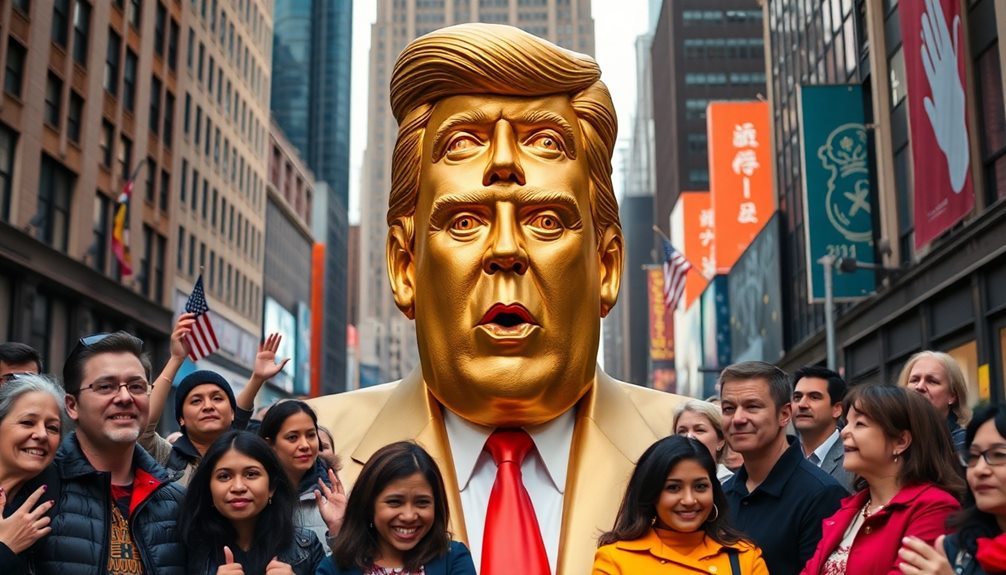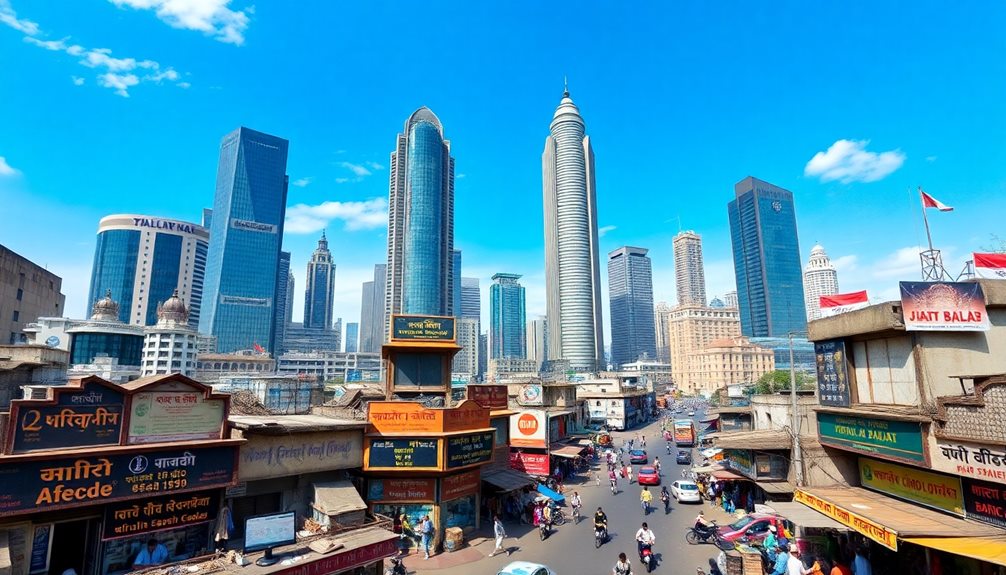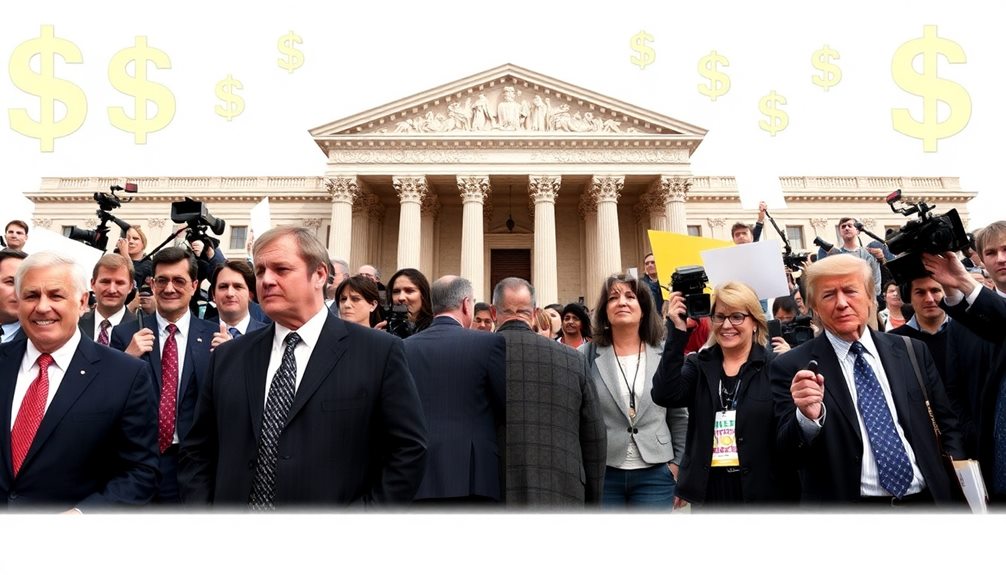You can't miss the growing controversy over Trump statues popping up across the U.S. These sculptures ignite fierce debates about his polarizing legacy and serve as bold political commentary. Many, like the ones in Philadelphia and Portland, have sparked outrage or been hastily removed due to permit issues and vandalism. Statues often feature eye-catching designs, like an eight-foot figure behind a nude woman, and ignominious titles referencing Trump's past actions. As the 2024 election looms, these pieces challenge you to consider the boundaries of art and political expression. Keep exploring to uncover the broader impact of these installations.
Key Takeaways
- Controversial Trump statues have emerged across the U.S., serving as political commentary on his contentious legacy ahead of the 2024 election.
- Statues in cities like Philadelphia and Portland have faced rapid removal or vandalism, highlighting polarized public reactions to political art.
- Artistic expressions feature provocative titles and plaques referencing Trump's controversial comments, aiming to stimulate discussions about his impact.
- The placement of statues often near nude female figures serves as a critique, reflecting growing discontent with Trump's presidency.
- Viral memes and social media discussions surrounding these statues emphasize debates over freedom of speech and the boundaries of political satire.
Introduction
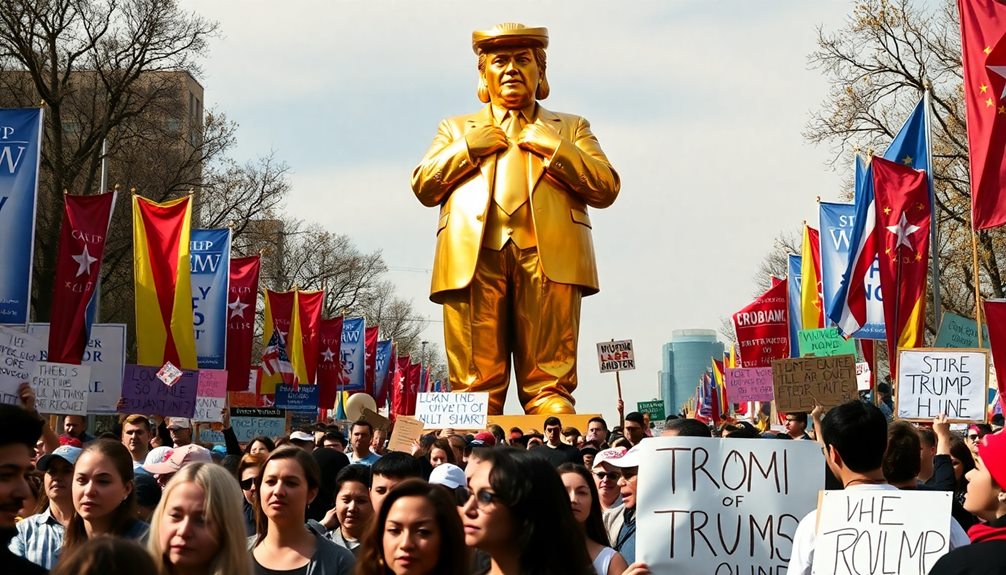
The emergence of controversial statues depicting Donald Trump across the U.S. has sparked intense debate and artistic expression. These Trump statues serve as provocative political commentary, showcasing the artist's take on his controversial legacy. In cities like Philadelphia and Portland, these installations highlight the complexities of public opinion surrounding Trump's actions and statements. While some view these installations as bold artistic statements that challenge the public to confront uncomfortable truths, others see them as inflammatory and divisive. The Donald Trump statue controversies have ignited public protests and heated online debates, reflecting the deep polarization within American society. Whether admired or condemned, these statues underscore the power of art to provoke dialogue and stir emotions in a politically charged environment.
For instance, one statue in Philadelphia was quickly removed due to a lack of a permit, while another in Portland was vandalized within a day, illustrating the polarized reactions these artworks elicit. Many of these pieces feature bold titles and plaques referencing Trump's past comments, such as "In Honor of a Lifetime of Sexual Assault," which quotes his infamous Access Hollywood tape.
Newer installations, like "The Donald J. Trump Enduring Flame" in Washington, D.C., take aim at his defense of white nationalists during the 2017 Charlottesville rally.
These artistic expressions aim to combat "resistance fatigue" among the public and spark critical discussions about Trump's controversial legacy, especially with the 2024 presidential election on the horizon.
It's clear that these statues have become a battleground for political dialogue and artistic dissent.
Background
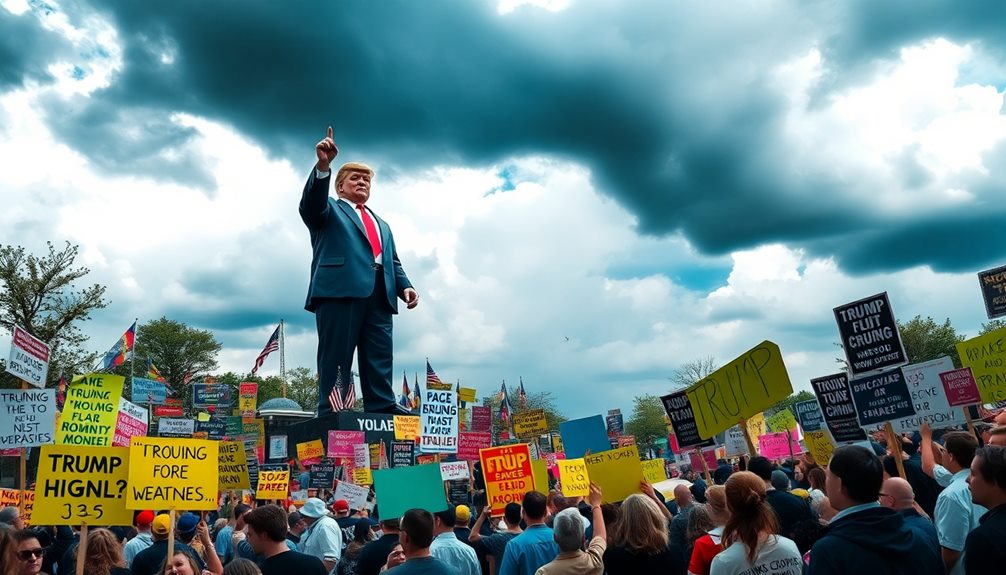
Artistic expressions criticizing Donald Trump have gained momentum in recent years, reflecting a growing discontent among various communities.
These anti-Trump statues have popped up in several U.S. cities, most notably in Philadelphia and Portland. In Philadelphia, an eight-foot sculpture of Trump, positioned behind a nude woman, was installed but quickly removed due to permit issues. This initial piece set the stage for more provocative installations.
In Portland, a similar statue faced vandalism when a local Trump supporter beheaded it, showcasing the polarized reactions these artworks can provoke. Such incidents emphasize the contentious nature of political art.
Other notable pieces, like "The Donald J. Trump Enduring Flame" in Washington D.C., criticized Trump's defense of white nationalists during the 2017 Charlottesville rally, but were also taken down shortly after their unveiling.
The anonymous artist behind these statues seeks to combat "resistance fatigue" and spark political dialogue, especially as the 2024 presidential election approaches.
Each statue serves as a reminder of the deep divisions within American society, aiming to challenge viewers and inspire discussion about Trump's legacy and impact.
Statues Appear in Unexpected Locations

Unexpected locations have become the backdrop for the latest wave of anti-Trump statues, surprising many with their bold placements. In cities like Philadelphia and Portland, these statues of Donald Trump often find themselves near existing nude female sculptures, creating a sharp critique of his controversial history.
One notable installation in Philadelphia featured an eight-foot statue that included a plaque quoting Trump's infamous Access Hollywood tape. Unfortunately for its creators, city crews removed it shortly after due to permit issues.
In Portland, a similar statue faced a swift backlash; a local Trump supporter vandalized and beheaded it, showcasing the polarized reactions these pieces evoke.
Meanwhile, in Washington, D.C., the "Trump Enduring Flame" statue appeared in Freedom Plaza, mocking Trump's defense of white nationalists during the 2017 Charlottesville rally before suffering the same fate as its counterparts—vandalism and removal.
Additionally, a larger 43-foot nude Trump statue features in the "Crooked and Obscene Tour," displayed on private property in Madison, Wisconsin, after previous showings in cities like Las Vegas, Detroit, and Phoenix.
These unexpected placements continue to spark intense conversations and reactions across the nation.
Viral Memes Flood Social Media
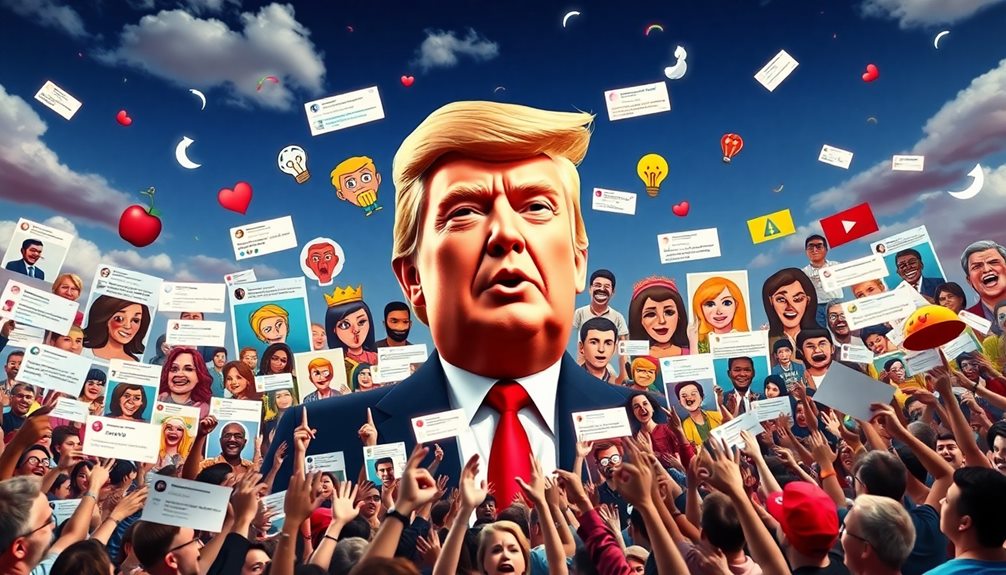
As anti-Trump statues continue to pop up across the country, social media has exploded with viral memes that highlight the absurdity and controversy surrounding these installations. From the provocative titles like "In Honor of a Lifetime of Sexual Assault" to the shocking imagery of a nude Trump statue, these memes serve as a form of political satire, creatively critiquing his public persona and actions.
You'll find users merging images of the statues with popular meme formats, sparking conversations about freedom of speech. One viral video showcasing the vandalism of the Portland statue, where a Trump supporter beheaded it, further fuels this meme culture.
It's fascinating to see how quickly the public reacts; meme creators jump on the opportunity, using humor to comment on the polarized political climate as the 2024 presidential election approaches.
These viral memes not only entertain but also provoke thought, making you question the boundaries of political expression. With each share and retweet, the conversation around these anti-Trump statues grows louder, illustrating just how impactful a meme can be in today's digital landscape.
Public Reactions Spark Heated Debates
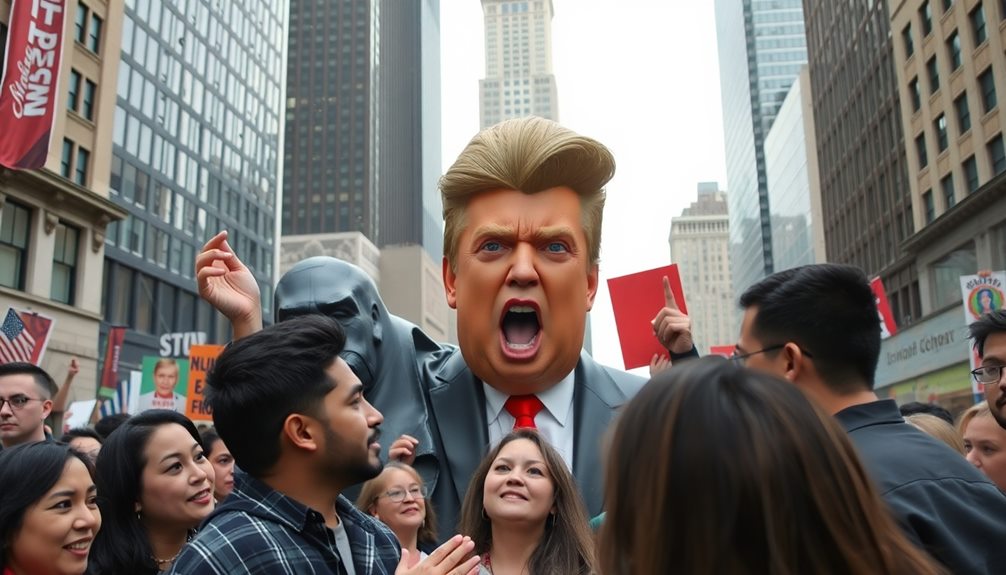
Public reactions to the anti-Trump statues have ignited heated debates across the nation. Take, for example, the Trump statue in Portland, which was vandalized and beheaded by a local supporter within a day of its installation. This incident highlights the polarized reactions to the artwork, with public discourse becoming increasingly contentious.
In Philadelphia, city crews had to remove a Trump statue shortly after its unveiling due to a lack of proper permits, further illustrating how divisive these political commentaries can be.
Some people view the statues as a legitimate form of artistic expression, while others find them offensive and inappropriate. This tension reflects a broader societal struggle regarding Trump's legacy and the role of artistic critique in politics.
Video evidence showcasing the destruction of the Portland statue has intensified discussions about freedom of speech and the limits of political satire in public spaces. As these events unfold, it's clear that the Trump statue controversy serves as a flashpoint for deeper conversations about art, politics, and societal values, leaving many to wonder where the line should be drawn in public discourse.
Frequently Asked Questions
What Materials Are Used in the Trump Statues?
When you explore statues like these, you'll find materials such as bronze, resin, and fiberglass commonly used. Each material offers unique textures and durability, enhancing the statue's visual impact and longevity in public spaces.
How Many Trump Statues Have Been Created Worldwide?
You might be surprised to learn that over a dozen Trump statues have appeared worldwide. These sculptures vary in style and material, often sparking debates about their artistic value and cultural significance in today's society. Some critics argue that these statues serve as political commentary, either satirical or reverential, depending on the artist’s intent. The trump statue controversy has fueled discussions around free expression and the boundaries of art, with some installations being defaced or removed due to public outrage. Whether seen as provocative art or mere spectacle, these statues undeniably ignite strong emotional responses globally.
Who Are the Artists Behind the Trump Sculptures?
You might find various artists behind the Trump sculptures, including prominent figures like Jeff Koons and a few lesser-known creators. Each artist brings their unique perspective, reflecting their thoughts on politics and society through their work.
Are Any of the Statues Permanently Installed?
You'll find that some of the statues aren't permanently installed; they're often displayed temporarily at various events or locations. Artists usually prefer to create a conversation, moving them around instead of fixing them in one place.
What Legal Issues Have Arisen Regarding the Statues?
You'll find various legal issues surrounding the statues, including potential violations of public space regulations, copyright disputes, and debates over freedom of expression. Local governments and organizations often clash over their installation and public perception.

